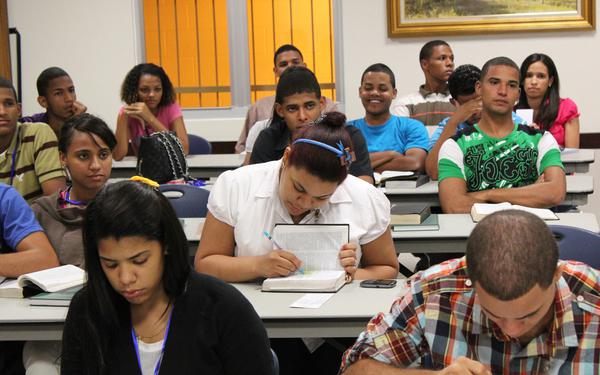See—and Hear—the One: Using the Principles of Effective Listening

Take a moment to look at each young adult in the above photo of an institute class. What do you notice about the students? What can you tell about them just by looking at them in a picture? What do you think each of them was thinking about or feeling right at the moment the picture was taken?
The simple truth is that we don’t know everything about our students simply by looking at them. However, this year’s See the One priority has challenged us to develop the Christlike ability to see each student’s individual needs, strengths, and divine potential. Listening effectively is one of the most important and simplest skills we can use to accomplish this goal.
Because effective listening is such an important skill in teaching, each of us should take a moment to evaluate how well we are listening to our students. Consider the following:
- Is there room for improvement in the way you listen to your students?
- Have you ever made a faulty assumption about what a student was thinking based on his or her facial expression?
- Does your mood affect how well you listen and respond to students?
- Have you noticed that students’ participation in class discussions can be affected by whether they liked or understood something being taught?
Because we want our students to know we care about them, we want to avoid interactions with them that leave them feeling like we didn’t listen to them or that we made inaccurate assumptions about them.
The Four Principles of Effective Listening
Please take the time to carefully study the following four principles of effective listening.
Be Quick to Observe and Discern (see Mormon 1:2)
The first principle of effective listening is to be quick to observe and discern. Most reasons for inappropriate behavior and the need for discipline arise out of unmet needs. We are often so quick to try to correct a behavior that we don’t take the time to know what the underlying unmet need is.
Pay attention to emotions, behaviors, and concerns. Seek further understanding by talking with the individual about your observation. Saying something as simple as “I’ve noticed that you often put your head down. How are you doing? Is everything okay?” can have a tremendous impact.
Pause and Consider Before Responding (see James 1:19)
Be careful to not assume or respond too quickly to a student’s comments or behaviors. Pausing before responding to a comment or behavior may seem like a simple thing, but it can make a significant difference in how the rest of your interaction goes. Take a moment to reflect and consider three possible reasons why a student may be responding in a certain way rather than making an inaccurate conclusion.
For example, imagine that you have a student in your class who is continually on his cell phone playing games and texting. You have asked him to put his phone away, but he refuses. Take a moment to think of three potential reasons for his behavior.
One reason may be that he is disinterested and doesn’t really care. This might actually be the reason for his behavior. However, what could be some other reasons? Could it be that this young man can’t read well and thinks that if he is always on his phone and appears disinterested you won’t call on him to read? Or, could it be that he is struggling with his testimony and he wants something to distract him from thinking about the things he’s struggling with?
How does thinking about multiple possibilities for this young man’s behavior instead of simply concluding that he is disinterested change how you might approach and respond to him? Be willing to take the time to consider why your students may be acting in specific ways before you respond to them.
Assure Your Understanding
Taking time to ask clarifying questions can help your students avoid feeling misunderstood. The next time a student responds to you or expresses a feeling, try this phrase: “What I think you are saying is …” Then repeat back what you understood. Finally, ask one more question: “Am I understanding you correctly?”
Asking these questions will help ensure you truly understand what your student is thinking and feeling and will also help you answer questions students may have but may not be directly asking.
Express Gratitude
When a youth or young adult lets you know how he or she is feeling or what has been going on in his or her life, let the individual know that you are grateful for the interaction and the trust that has been demonstrated. Students don’t owe us any explanation about why they are acting or responding in a certain way. Express gratitude that they trust you enough to share what is happening in their lives.
Potential Inservice Idea
As a faculty, practice the following principles of effective listening:
- Think of individuals in your classes who have some behavioral struggles.
- List three potential reasons why they may be acting in specific ways.
- Before talking to a student who needs help, practice what you will say. Remember to use the phrase “What I think you are saying is …”
- Practice expressing gratitude for what students share with you.